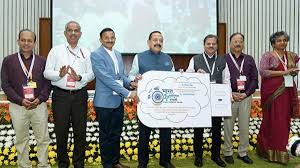Bharat Forecasting System:

The India Meteorological Department (IMD) will soon adopt the Bharat Forecast System (BFS), which offers the highest resolution among weather models.
- Bharat Forecasting System (BFS) is an indigenously built advanced weather forecasting system.
- It was developed by the Pune-based Indian Institute of Tropical Meteorology (IITM).
- It will provide forecasts with a 6 km resolution — the highest in the world — that would allow forecasters to predict small-scale weather features more accurately.
- This resolution is advanced in comparison to the previous 12-km Global Forecast System (GFS) used in India so far.
- This finer resolution will help in more precise predictions of localised weather events like heavy rainfall and cyclones.
- It is powered by the Arka supercomputer.
- This supercomputer has 11.77 petaflops (a unit to measure computer processing speed) and 33 petabytes (a petabyte is 1,000 terabytes (TB)) of storage.
- The supercomputer is located at IITM, Pune, and will massively reduce forecasting time compared to the older Pratyush
- Data from a network of 40 Doppler Weather Radars from across the country will be used to run the BFS model that would enable the weather office to issue more localised forecasts as well as nowcasts — weather forecasts for the next two hours.
- Gradually, the number of Doppler radars will increase to 100, which would allow the weather office to issue nowcasts across the country.
- The BFS can provide 6 km resolution forecasts for the tropical region that falls between 30 degrees South and 30 degrees North Latitudes.
- The Indian mainland extends between 8.4 degrees north and 37.6 degrees north latitudes.
- BFS is primarily a numerical weather prediction (NWP) model, but recently integrated AI and machine learning (ML) to enhance its working.
- Unlike most of the global models, BFS data will remain accessible to researchers worldwide, fostering collaborative advancements in meteorological science.




